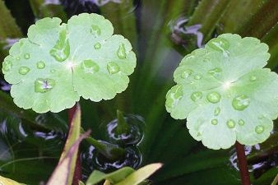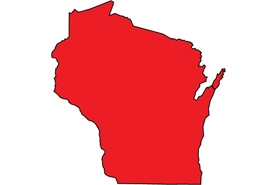Floating marsh pennywort
(Hydrocotyle ranunculoides)
Extremely fast-growing floating aquatic plants can grow up to 20 cm per day and 15 m from the bank in a single season and double their biomass in 3 to 7 days.
Other names for this plant include:
- Common names: floating pennywort, marsh pennywort, water pennywort
- Scientific names: Hydrocotyle natans, Hydrocotyle cymbalarifolia, Hydrocotyle batrachioides, Hydrocotyle ranunculoides forma lobata, Hydrocotyle ranunculoides forma genuina
Classification in Wisconsin: Prohibited
- Ecological Threat
-
- It invades freshwater lakes, reservoirs, ponds, marshes, slow-flowing streams, and rivers, making boating, fishing, and almost all other water activities difficult.
- Degrades water quality by blocking the air-water interface and significantly reducing oxygen levels in the water, impacting underwater animals such as fish.
- Significantly reduces biological diversity: mats block sunlight, preventing the growth of submerged and emersed plant communities and also alter animal communities by blocking access to the water and lowering plants the animals depend on for shelter and nesting.
- Identification
-
Leaves: 2-6 cm in diameter, rounded or broader than long, with 3-7 lobes. The lobe divisions extend to about mid-leaf. The leaf edges are smooth to slightly scalloped. Slender stalks 5-35 cm long are attached to the leaf edge, although the limb may appear to be attached to the center of the leaf.
Flowers: tiny creamy yellow flowers (usually 9) approximately 3 mm in diameter on a short umbel below the leaf canopy.
Fruits & seeds: The fruit is 1-3 mm long, elliptic, round, and flattened with soft ribs. It is divided into two halves, each with a tiny persistent stalk.
Roots: Fine fibrous roots that penetrate the soil or drift in the water from the stem at nodes.
Similar species: Could be mistaken for other Hydrocotyle or Ranunculus species.
- Control
-
Mechanical: Removal by hand or machine is a practical control method often used for small areas or when numbers are low. Physical removal should be completed before the flowering and seed set. Care should be taken to collect and destroy all parts of the plants.
Chemical: Registered aquatic herbicides can provide some control in small-scale applications. Application of aquatic herbicide requires a permit.
- Resources
- Sources for content:
- CABI Factsheet [exit DNR]
- Illinois Wildflowers: Factsheet [exit DNR]


